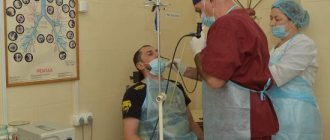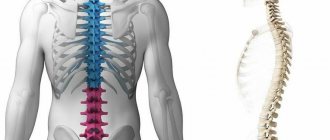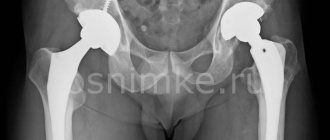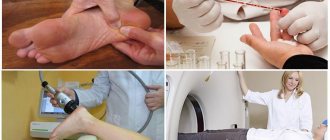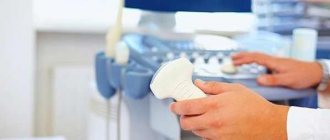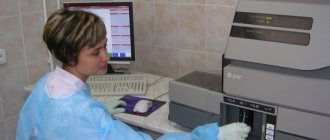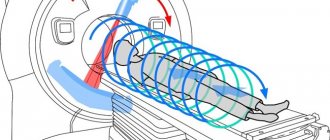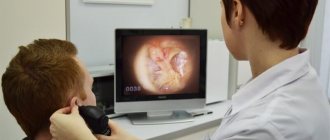Audiometry is a procedure for studying human hearing, the process of determining auditory sensitivity to sound vibrations. By doing this, you can determine the so-called “hearing threshold” of the patient. Audiometric studies are carried out by an audiologist - a doctor who specializes in identifying and treating hearing problems. One of the key areas of his activity is the diagnosis of hearing disorders, including through the audiometry procedure. Typically, patients see an audiologist by referral from a general practitioner or otolaryngologist. In some cases, preventive examinations by this doctor are also necessary.
What is audiometry
In a normal state, human hearing is capable of perceiving a fairly wide range of sound vibrations. However, due to various reasons, for example, injuries, infectious lesions, congenital pathologies, the acuity of auditory perception may gradually or sharply decrease, and in some cases disappear completely. In this study, we encounter the concept of an auditory norm criterion - it is considered the level of perception by the patient’s ear of a whisper from a source located at a distance of six meters from him.
Content:
- What is audiometry
- Types of audiometry
- Indications for audiometry
- How to prepare for the procedure
- Decibels and Hertz
- Procedure for speech audiometry
- Pure-tone and threshold audiometry
- Suprathreshold audiometry
- Computer methods for hearing research
- Objective audiometry to detect hearing system lesions
- Features of pediatric audiometry
- The concept of an audiogram, the mechanisms of its decoding
- Normal audiometry results
- Is it possible to falsify audiometry results?
The audiometry technique is painless and harmless to the patient, it does not require any special training, and special devices and devices are not always needed for its implementation, which is why it is recommended for both adults and children. At the same time, with its help it is possible to identify disturbances in the functioning of any parts of the hearing system, and regular preventive examinations of this kind make it possible to identify and prevent hearing loss in the early stages of the occurrence of such a possibility. In addition to, in fact, determining the very fact of hearing loss, an audiologist during audiometry can calculate the degree of such decrease. The procedure must be carried out before the appointment of hearing aids.
After receiving the results of this diagnostic procedure, the doctor can evaluate the quality of the entire hearing aid using the air conduction method, or study the functionality of the inner ear using the bone conduction method. In the first case, sound waves cause vibrations of the eardrum through the external auditory canal, for which speakers or headphones are used, and in the second, the sound source comes into contact with the head, causing vibration of the bone apparatus of the skull, and, in turn, vibrations of the eardrum. The task of stimulating the bones of the skull is performed by special bone oscillators.
Advantages and disadvantages of the procedure
The completed examination allows us to diagnose hearing disorders with the greatest accuracy, in comparison with other similar procedures. With audiometry, a complete and comprehensive analysis and assessment of hearing pathologies is carried out based on deciphering the test results, given in decibels. While other methods of similar research imply the doctor’s conclusions based on personal opinion.
Also, the advantages of the procedure include the time spent on examination, which is significantly shorter than a similar operation performed using tuning forks. In a short period of time, the device will not only assess existing hearing impairments, but will also display the results of the study. Such functions make the device convenient for mass examinations of patients for preventive and therapeutic purposes.
An examination with an audiometer helps to identify even the initial stages of hearing pathologies and give an accurate assessment of existing disorders.
Audiometry has no contraindications and does not cause even the slightest discomfort, which makes the operation accessible to all age groups of patients.
The disadvantages of audiometric examination include its subjectivity. It is expressed in the appearance of not entirely reliable information on the graph due to the fact that it is not always possible to obtain honesty from patients. That is, the patient needs to press the button only in the situation when he actually hears something.
The procedure must be carried out in a room that is completely isolated from extraneous sounds, which creates significant difficulties in equipping the place for the examination.
Audiometry will only give approximate results when examining bone conduction at a higher tone, but despite this, today this method of hearing testing is the most effective.
Types of audiometry
Depending on how the examination is carried out, what devices and devices are used, there are several main types of audiometry. The simplest and most accessible is audiometry using live speech, without the use of special equipment. This type of speech audiometry is used mainly by otolaryngologists if the patient during a consultation complains of hearing impairment or ear congestion. During the examination, the doctor moves away from the patient at some distance, after which he begins to pronounce phrases and words at different volumes, from normal conversational to whispering. Based on how the patient responds, how clearly and accurately he can repeat what he heard, the doctor can already draw certain conclusions. Unfortunately, this technique is not completely reliable, since its results, not least of all, depend on the patient’s level of development and age.
Types of audiometry using technical devices:
- speech – is a technique for determining the perception of speech (live or recorded);
- tonal and threshold - examines the patient’s hearing perception of various sounds that are not related to human speech;
- suprathreshold - a technique used in cases of complete hearing loss. With its help, the specialist receives data on the differential threshold of sound perception;
- computer – carried out using special computer systems and programs;
- objective – based on fixation of unconditioned auditory reflexes;
- children's - used as a method of testing hearing in newborn babies and older children.
An audiometer device is used to display the obtained data on the subject's hearing acuity.
Hearing test for children
The first signs of hearing loss can be noticed at an early age, so it is very important to know how audiometry is performed in children. Tone threshold audiometry is used for children and depending on the age of the subject and can be unconditional reflex (from birth to 7 months), conditioned reflex (from 7 months to 3 years), and play (from 2 to 7 years).
Unconditional reflex method
This method consists of assessing the child's reaction to sound. The results of its implementation are indicative in nature, since much depends on the condition of the child. Hand-held audiometers, rattles, and tweeters are used as a sound source.
Conditioned reflex method
This method can be completed only after 7 months, when the child develops the ability to localize sound in the “left-right” plane. The sound delivery is visually reinforced by the monitor with an image appearing on it that attracts the child. He has a conditioned reflex to sounds, and he turns his head in the direction where the sound source is located.
Game audiometry
Play audiometry is usually performed after 2 years of age. To successfully use this audiometry method, parents need to prepare their child in advance. It is necessary to teach him to react to sound, namely, to perform some action at the moment of sound (for example, throwing objects into a jar, putting a pyramid ring on a rod). While in the research room, the child plays, and when the sound from the audiometer comes through the headphones or bone phones into his ear, he performs his usual actions. This is a signal to the audiologist that the child has heard the sound.
Important! Play audiometry is carried out only if the child understands the task and can complete it.
When examined, most children show variability; they can perform one task in different ways. To obtain stable thresholds, audiometry is performed several times.
Indications for audiometry
In addition to systematic examinations to prevent hearing impairment, there are situations when testing hearing acuity is necessary for objective reasons, for example:
- for diseases of the middle and inner ear, especially if the patient himself notes a deterioration in auditory perception;
- due to brain diseases associated with damage to the auditory cortex of the brain;
- upon receipt of injuries to the ears and head, which led to a decrease in hearing acuity;
- if you suspect the development of occupational hearing loss;
- when hearing loss of unknown etiology is detected;
- before selecting and installing a hearing aid;
- for infectious ear diseases;
- after taking certain groups of antibiotics (Neomycin, Gentamicin), as well as large doses of salicylates;
- to check and evaluate the results of the treatment.
How to prepare for the procedure
Before starting to study the patient’s hearing acuity, the audiologist conducts a preparatory conversation and survey with him. The doctor finds out when the hearing problems began, whether they affect one or both ears, and whether the patient has ringing, pain or discomfort in the ears. The audiologist will also ask whether the patient has had any infectious diseases or ear injuries, what is the noise level in the patient’s workplace, and whether other members of his family have hearing problems.
The examination includes visual examination of the outer ear for visible deformities, as well as examination of the ear canal and eardrum using an otoscope.
No special preparation measures are required before audiometry; however, if possible, it is better to avoid being in noisy places (discotheques, concerts, runways) before it is carried out, and also not to listen to music on headphones.
Decibels and Hertz
The use of decibels as a unit for determining the loudness of sound vibrations is due to the fact that the human ear is capable of perceiving sounds over a wide range of intensities. For example, the volume of a whisper is about 20 dB, the intensity of noisy music can range from 80 to 120 dB, and the volume of a jet engine reaches 140-180 dB. Exposure to sound levels greater than 85 dB for several hours can cause temporary hearing loss. Exceeding the discomfort threshold (more than 112 dB) causes persistent pain and can also cause hearing loss.
Hertz allows you to record such a property of a sound wave as frequency, or pitch. Hertz refers to the number of air vibrations per second that affect the eardrum. The bass tonality ranges from 50-60 Hz. On average, the operating range of the human hearing aid ranges from 20 to 20,000 Hz. The high tones range is above 10,000 Hz. Human speech has a frequency between 500 and 3000 Hz.
Decoding threshold designations for hearing impairment
After undergoing a complete diagnosis, five degrees of deviation from the norm are distinguished:
- Initial audibility, a barely audible sound appears. Normally this occurs at a frequency of 5-10 dB.
- If the patient is able to identify 20% of all words heard, this is the second threshold. Located at 25-30 dB.
- When it is possible to distinguish 50% of words, a third threshold is defined. In healthy people it is at the level of 30-35 dB.
- The threshold of 80% is the fourth most intelligible. It is located at the level of 35-40 dB.
- 100% intelligible speech. The fifth threshold for the option without hearing impairment is located at the level of 45-50 dB.
Thresholds of 1.3-4 are diagnostically significant, since the function of initial audibility is important.
Procedure for speech audiometry
To carry out the procedure, the patient is placed in a sound-attenuated or soundproof room. The sound is supplied through telephone headphones or into a speaker. In the second case, the subject should be at a distance of approximately 25-30 centimeters from the sound source. Speakers or headphones reproduce a digital recording of the speaker's speech, or transmit his live speech. The patient voices the words spoken by the announcer into a special microphone.
The diagnostician, hearing the text transmitted to the subject and analyzing the patient's answers, changes the intensity of the sound using a special electronic device - an attenuator, and monitors how the patient perceives the spoken text. In this way, the doctor determines the minimum volume (threshold intensity) of speech at which the subject hears at least 2/3 of the entire text.
Headphones in this method are used most often when it is necessary to study each ear separately.
If a live announcer speaks text into a microphone, he must pay attention to the voltmeter readings to determine the volume of the speech. This method is considered more convenient, since, firstly, it allows for closer contact between the doctor and the person being examined, and secondly, an audiometer without a recording device provided in the design has a significantly lower cost. At the same time, recording ensures that the volume of the spoken text will be more stable. As for whether to use a male or female voice for the examination, judging by the reviews of doctors, no significant difference in the results of speech audiometry, depending on the gender of the speaker, was found. But the constancy of the frequency characteristics of the spoken material, as well as the adequacy of the diversity of the text, plays an important role in conducting the study. For example, to determine the auditory perception of the Russian language, through audiometry, special lists of words have been compiled in the form of tables. With their help, you can establish the degree of intelligibility of the Russian language for the subject.
Scientists and audiologists also note that, for example, the use of single isolated words or long meaningful sentences equally negatively affect the examination results, making them less objective. When pronouncing single words, patients experience greater hearing loss, and in the case when the subject hears coherent, meaningful speech consisting of logically composed sentences, the chance that he can guess or think of unheard phrases or words increases. The best option is to use phrases consisting of two or three logically related words.
For a full examination of the capabilities of a person’s hearing system, such an indicator as the dynamic range of speech perception, which is directly related to the concept of the threshold of unpleasant sensations, is also important. In the presence of persistent hearing loss, the threshold may increase - in this case, the dynamic range remains unchanged. If the threshold of unpleasant sensations remains at the normal level, the range narrows.
There is also a criterion for favorable and unfavorable levels of speech perception. In the first case, the patient can perceive speech normally for a long period of time, and in the second, usually no more than 2-3 minutes. In people with a normal level of hearing acuity, the threshold for perceived loudness is more than 60 dB, and unpleasant sensations are caused by sounds louder than 112 dB. An increase in the threshold of unpleasant sensations by 5-10 dB is observed with damage to the sound-conducting apparatus, and a decrease is observed with some progressive processes, for example, with toxic neuritis.
Degrees of hearing loss
Difficulty in perceiving speech and surrounding sounds depends on the degree of hearing loss. The degree of hearing loss according to the threshold tone audiogram is calculated as the arithmetic mean of the hearing thresholds of air-conducted tones at frequencies of 500, 1000 and 2000 Hz.
Minimum hearing loss 16-25 dB
Audiometry. Thresholds of hearing of air-conducted tones with a minimal degree of hearing loss.
Difficulty perceiving quiet speech in noise. Minimal hearing loss in childhood leads to difficulty understanding speech. With average hearing thresholds of 16 dB, students do not receive up to 10% of speech information if the teacher is more than 1 meter away. At average hearing thresholds of 20-25 dB, problems arise with recognizing speech sounds s, h, f.
Mild hearing loss 26-40 dB
Thresholds of hearing of air-conducted tones in mild hearing loss.
It is difficult to perceive quiet or distant speech in silence and noise. Normal conversational speech can be heard in quiet conditions, but speech intelligibility is impaired in noise. Whispered speech cannot be heard. A mild degree of hearing loss in childhood leads to the fact that children do not receive 25-40% of speech information, poorly distinguish consonant sounds, strain when listening and quickly get tired, giving the impression of being absent-minded. Pronunciation defects may develop and school performance may decline.
Average hearing loss 41-55 dB
Thresholds of hearing of air-conducted tones with moderate hearing loss.
Conversational speech can be heard at a short distance from the speaker; speech perception in noise is significantly deteriorated. Quiet sounds and whispered speech are not heard. In children, an average degree of hearing loss leads to a loss of 50-100% of speech information, depending on the listening conditions; children can understand simple phrases with familiar words at a distance of up to 1-1.5 meters. To understand speech, children use visual information (lip reading), their vocabulary is poor, their speech is distorted, their voice is monotonous, and many consonants are pronounced incorrectly.
Severe hearing loss 56-70 dB
Thresholds of hearing of air-conducted tones in severe hearing loss.
Loud conversational speech can be heard close to the ear. Children with a hearing loss of 55 dB lose 100% of speech information; can distinguish loud speech at a distance of up to a meter; speech does not develop.
Profound hearing loss 71-90 dB
Thresholds of hearing of air-conducted tones in severe hearing loss.
Very loud speech can be heard right next to the ear; loud sounds can be heard at a distance of 30-50 cm from the ear.
Deafness
Thresholds of hearing of air-conducted tones in deafness.
In case of deafness, average hearing thresholds exceed 90 dB HL. In some cases of deafness, loud sounds and screaming may be heard at the auricle. In clinical deafness, hearing thresholds are not determined when stimulated with a sound pressure level of 120 dB HL, and there is no response to sound stimuli. Auditory communication is impossible.
Pure-tone and threshold audiometry
To determine the limits of a patient’s sound perception, the doctor conducts an examination in the frequency range from 125 to 8000 Hz, and establishes at what values the patient hears sounds normally. This type of study is carried out using an audiometer. This equipment allows the use of sound signals of varying degrees of intensity - from 125 Hz, and then increasing (250, 500, 750 and more Hz), up to frequencies of 8000 Hz. Devices with available frequencies of more than 10,000 Hz are used less frequently. The switching step is 67.5 Hz. This technique allows you to determine the minimum and maximum values - the level of occurrence of a discomfort state, using both pure tones and a narrowly targeted noise curtain.
The audiometers used in these cases have over-ear headphones, which are two separate air phones, or two in-ear phones that are inserted into the auricle. They also include a bone vibrator used to study bone sound conduction, a microphone and a button intended for the patient. A recording device connected to the audiometer records the results of the examination.
The room intended for the study must be soundproofed. If this requirement is not met, when analyzing test results, the doctor must take into account that they may be influenced by external noise. However, in-ear phones can solve this problem - their use allows you to obtain the most objective results, eliminate the possibility of collapse of the external auditory canal, and also reduce the overall natural noise by 30-40 dB. In this case, the level of interaural relaxation increases to 70-100 dB, which significantly increases the patient’s comfort during the examination.
A signal of a specific tone is transmitted to the patient through headphones, and if he hears it, he presses a special button. If the doctor sees that the button is not pressed, he raises the tone until the subject hears it and presses the button. This determines the minimum value. The maximum perception is revealed in a similar way - when the signal level exceeds the limit of audibility, the patient releases the button. The examination results are displayed in the audiogram.
The normal threshold of hearing is a volume of 0 dB. Switching sound indicators occurs in 5 dB steps, reaching 110 dB. Deviation from the zero level is allowed no more than 15-20 dB - in this case the result is considered normal.
Suprathreshold audiometry
In cases where a patient is diagnosed with deafness, it will be quite difficult for the doctor to accurately determine the location and cause of the lesion. For these purposes, the method of suprathreshold research is used. This includes:
- noise studies;
- Fowler tests and Luscher technique;
- Langenbeck tests.
Based on the results of this type of audiometry, it is possible to determine whether the pathology is localized in the ear labyrinth, vestibular or auditory nerve cells.
The Luscher method is the most popular today. With its help, the audiologist determines the differential threshold for the perception of sound wave strength (index of small increases in intensity). Suprathreshold audiometry allows you to balance the strength of the signal using the Fowler technique, as well as fix the initial limit of discomfort.
The examination procedure is carried out in this way: the patient receives an audio signal with a frequency of 40 dB above the hearing threshold through headphones. The signal is modulated in the range between 0.2 and 6 dB. Testing begins at a level 20 dB above the hearing threshold, with a gradual increase in sound intensity, at intervals of 4 seconds. In 0.2 seconds, the sound intensity increases by 1 dB, the patient describes his sensations, and the doctor examines their correctness.
Having brought the indicators to 3-6 dB, the doctor explains to the subject the essence of the test and returns the signal intensity to 1 dB. If a sound transmission defect is diagnosed, the patient is able to distinguish about a 20% increase in tone intensity in the process.
With diagnosed conductive hearing loss (impaired passage of a sound signal along the auditory pathway), the norm is a disturbance in the conduction of sound waves from the outer ear to the eardrum, with the modulation depth ranging from 1 to 1.5 dB. With cochlear hearing loss (non-infectious damage to the inner ear), the level of recognizable modulation is significantly lower - about 0.4 dB.
Testing of loudness equalization according to Fowler is mainly relevant if the development of an acoustic neuroma (benign tumor) or Meniere's disease (a pathology of the inner ear in which the amount of endolymph increases in it) is suspected. Most often, it is performed if unilateral hearing loss is suspected, however, this is not a mandatory rule. With bilateral hearing loss, it is possible to use this suprathreshold method if the difference in the hearing thresholds of both sides is no more than 40 dB. In this case, a sound that has a threshold value for a specific hearing aid is simultaneously applied to each ear, after which the signal entering the deaf ear is increased by 10 dB, while selecting such an intensity in the second ear that, according to the patient’s perception, both signals are of the same tone . Next, the procedure for raising the tone and leveling the volume in both ears is repeated.
What is TPA?
Pure Tone Threshold Audiometry (TPA) is a hearing test method. This study is carried out by a doctor using a special algorithm: hearing thresholds are determined at a given set of frequencies. A significant advantage of TPA is the alternate diagnosis of the right and left ears, which allows making a separate conclusion for each ear. TPA can be performed on children over six years of age. This is an absolutely safe, accurate and relatively inexpensive way to determine various types of hearing loss. Tone threshold audiometry is a purely diagnostic method. If your child is recommended to undergo THA, do not panic: this does not mean that the child needs a hearing aid or that the hearing loss is irreversible. There are many conservative (mostly physiotherapeutic) methods of hearing correction, including plasmapheresis, electrical stimulation and laser therapy.
Computer methods for hearing research
This method of examination does not require the active participation of the test subject; it can be applied even to newborn children. Computer audiometry is considered the most reliable and informative way to study the capabilities of human hearing, since the objectivity of the data obtained does not depend in any way on the patient or the doctor’s ability to interpret the result. The procedure is performed while the patient is in a state of sleep. Special electrodes are connected to his head, and sound signals of different frequencies are sent to his ear using headphones. A computer program records brain reactions and builds an audiogram based on them.
Objective audiometry to detect hearing system lesions
This method of hearing examination is especially often used for newborn infants and young children. The results of objective audiometry are based on an analysis of the reflexes of the human body, which are triggered in response to certain sound stimuli and are recorded regardless of the patient’s actions or desires.
These reflexes are:
- dilation of the pupil (cochlear-pupillary reaction);
- closing of the eyelids upon unexpected sound exposure (auropalpebral reflex);
- contraction of the orbicularis oculi muscle;
- in infants - inhibition of the sucking reflex as a reaction to different tones of the sound signal;
- reactions of the vascular system, for example, the degree of vasoconstriction;
- galvanic skin response, which is measured as the electrical conductivity of the body through the skin of the palms.
The most modern methods used to diagnose hearing are:
- Acoustic impedance measurement: as a result of its implementation, the condition of the middle ear can be assessed. Within the framework of this technique, two procedures are performed - tympanometry and registration of the acoustic reflex. The first type of study gives the doctor the opportunity to diagnose the level of mobility of the eardrum and the chain of the bone component of the hearing aid, and allows one to determine the degree of resistance of the air cushion in the cavity of the eardrum under conditions of various micro-oscillations in the external auditory canal. As for the acoustic reflex, we are talking about recording a signal from the intra-ear muscles in response to an impact directed at the eardrum.
- Electrocochleography is a diagnostic method performed with artificial electrical stimulation of the auditory nerve. This stimulation causes activation of the cochlea.
- Electroencephaloaudiometry is a procedure that allows you to record the evoked potential of the auditory zones of the cerebral cortex (during its implementation, an electroencephalogram is recorded).
The known effectiveness of this type of examination is that it can be carried out on those patients who do not want or cannot, for example, due to age, contact an audiologist. Such patients include the mentally ill, newborn infants and young children, criminal defendants, and prisoners.
How is this research conducted?
The subject is located in a sound-insulated room and puts on headphones. His job is to press a button when a beep is heard. The specialist gives signals of different tones and strengths, changing them upward until the patient presses the button. The highest level of sound perception is studied in a similar way.
Testing begins with the right ear, then examines the left. It is this test sequence that allows you to get a more complete picture of auditory pathology.
Features of pediatric audiometry
Determining hearing impairment in a child is a complex problem. This happens mainly because a small child, and even more so a newborn baby, is simply not able to identify a disorder in himself and explain the situation in detail to his parents. It is also more difficult to work with children because it is more difficult to hold their attention during the research process, they get tired faster, which is why the results can be distorted.
The audiological examination of infants has a clearly defined scheme, which the audiologist adheres to. The doctor can conduct the first appointment with a tiny patient already on the 3-4th day of his life. Initially, the doctor performs an external otoscopy - visually assesses the condition of the outer ear and eardrum. Considering the specifics of the baby’s age, the possibility of detecting various types of contaminants (sulfur, birth lubricant), as well as external deformations or hyperemia, cannot be ruled out. In such cases, further diagnosis is made no earlier than 2 weeks after the hearing aid is cleaned and treated.
The method of tympanometry can be applied to a newborn - examining the condition of the eardrum and middle ear using a special probe that reproduces a series of frequencies with certain characteristics. Based on its results, it is possible to identify developmental pathologies, as well as the presence of infectious inflammatory diseases.
The next stage of examination of a newborn is the registration and analysis of evoked otoacoustic emissions. It is known that in response to a specific sound stimulus, the human hearing aid is capable of generating response impulses. It is on this principle that this diagnostic method is based. If deviations and violations are identified during the process, the child is referred for consultation to an otolaryngologist and audiologist.
Older children, for example, school or primary school children, can undergo hearing testing in a playful way - this makes it easier to get them to concentrate for a long time and be interested in the process. The technique is based on the possibility of developing a conditioned motor reflex as a reaction to a specific sound stimulus. The child is asked to perform a specific movement from those that he already knows at the moment the sound appears. Sound audibility is determined in the range from 250 to 4000 Hz, separately for each ear. Sound signals are given alternately at different frequencies.
The concept of an audiogram, the mechanisms of its decoding
The result of the hearing aid testing is an audiogram - indicators converted into a graph. The frequency of the sound is displayed along its horizontal axis, and the corresponding hearing threshold is displayed along the vertical axis, while the vector axis is at the top. The displayed sound wave threshold ranges from 125 to 8000 Hz.
A separate audiogram is compiled for each ear, which is designated differently: the graph of the right ear is marked as AD, the left - AS. The appearance of the graphs is also different - the audiogram of the right ear is displayed in red, and instead of dots, there are circles on it. For the left ear, the graph is displayed in blue and crosses instead of dots.
The graphs show the level of air and bone conduction: in the first case, the graph looks like a solid line, in the second - like a dotted line. In this case, the bone conduction line is always located higher than the air line. The distance between them is called the air-bone interval, and normally should not exceed 10 dB.
By reading the charts, the audiologist is able to diagnose hearing loss, its degree, as well as the presence and nature of other disorders. The most common types of hearing loss that a doctor can determine on a schedule are:
- conductive (when the air conduction of sounds is disrupted);
- mixed (if both types of sound transmission are impaired);
- sensorineural (in cases where bone sound conduction repeats air sound conduction).
The causes of hearing loss in some cases are also displayed on the graph, for example, if the air-bone interval is more than 20 dB, the doctor draws conclusions about the presence of conductive hearing loss, which appears as a result of otosclerosis or otitis media. The importance of the graph for the final diagnosis cannot be overestimated. Decoding the audiogram does not make it possible to draw absolutely accurate conclusions without further research.
When examining a patient, it is important for the doctor to determine the degree of damage and the level of hearing impairment. To do this, he pays attention to the location of the graph curve. In patients with mild hearing loss, decibel values are between 20 and 40 dB, with moderate hearing loss, the graph values are between 41 and 55 decibels, with moderate-severe hearing loss - from 56 to 70 dB, and severe hearing loss is depicted in values between 71 and 90 dB. The readings for each ear may vary. The range from 0 to 25 dB is considered normal. A graph of loudness above 91 dB indicates absolute deafness.
If the curve tends to go down, this indicates difficulty in perceiving high frequencies, and vice versa. The curve, which is shaped like a hyperbola, indicates that hearing loss is greatest in the middle of the range. In such cases, a person can only perceive very loud sounds. Audiogram indicators are necessary for diagnosing the degree of hearing loss and determining the cause of the impairment; its data is very important for the process of selecting a hearing aid.
What does an audiogram look like?
As a result of the study, the doctor receives an audiogram. This is a graph on which certain data is located. Along the horizon you can see the frequencies that were fed into the person’s ears.
The vertical line shows the hearing level that corresponds to each frequency. Hearing audiometry is carried out for each ear separately, so there will be 2 results. AD - for the right ear, AS - for the left ear.
Most often, for convenience, graphs are colored in different colors: for the right - red, for the left - blue.
An audiogram can determine both bone and air conduction of sounds. To determine bone conduction, a dotted line is used on the graph. The study is carried out using a bone vibrator, which transmits the necessary signals to the inner ear. Air conduction is drawn as a solid line, and sounds are transmitted to the person through headphones. Degrees of hearing loss may vary, so the lines on the result sheet will vary more or less significantly.
Bone conduction is always better than air conduction. Therefore, its line on range graphs will always be located above the second type. Between the lines there is a space called the air-bone interval. Most often, its value does not exceed 10 dB. With normal hearing, the line on the graphs will be flat. It will be close to 20 dB. There are standards by which a person’s hearing level is determined.
Normal audiometry results
During the diagnostic process, the doctor can conclude that the patient has a normal level of hearing acuity if he is able to hear whispers, the ticking of a clock, or normal speech. This is also evidenced by the symmetrical normal air and bone conduction of sound. In this case, the patient perceives sound frequencies from 250 to 8000 Hz at a volume of 25 dB and lower.
Best materials of the month
- Why you can't go on a diet on your own
- 21 tips on how to avoid buying stale food
- How to keep vegetables and fruits fresh: simple tricks
- How to curb your sweet cravings: 7 unexpected products
- Scientists say youth can be extended
When analyzing the data obtained, the doctor pays attention to some factors that may affect the results of audiometry, for example, the presence of occupational hearing loss, Meniere's disease, otosclerosis, perforation or rupture of the eardrum.
What to do with the test results?
Based on the results of the audiometry, the person is given a report. If this service is not included in the standard examination, you must request a copy of the results of the examination. It will not only allow you to select the optimal hearing aid, but will also help track the dynamics of hearing changes during further research or prevention.
If you have difficulty recognizing sounds or they have lost their “fullness,” then you should visit a hearing correction center and have audiometry performed. And the ability to read research results will allow you to become an active participant in your own treatment.
How are audiometry results interpreted?
The results are interpreted exclusively by an audiologist. It determines at what frequencies a person cannot hear audiometric sounds and identifies the degree and type of hearing loss. The prescription of a method for correcting disorders depends on a correct diagnosis.
The form contains two axes: abscissa and ordinate. The first axis shows frequencies in Hz, and the second axis shows the saturation of sound vibrations in dB. The audiogram consists of two graphs - for both hearing organs (red AD (left ear) and blue AS (right ear)).
Also on the form are the points of threshold hearing at specific frequencies. For the left ear, the points are indicated by crosses, for the right ear - in the form of circles. In addition, air and bone audiometry is performed to determine conduction levels. Two curves are entered into the form. The continuous line indicates air conductivity, the dotted line indicates bone conductivity. After air and bone audiometry, a bone conduction curve is plotted above the air conduction line.
The doctor deciphering the form looks at how the lines are located. If they are ascending, the patient has conductive hearing loss; if they are descending, the patient has sensorineural hearing loss.
Bone audiometry also helps determine the type of hearing loss. It is identified by the size of the air-bone interval. After bone audiometry is performed, air and bone conduction curves are entered into the form. The type of pathology is determined by the size of the gap between them.
Other results are interpreted as follows:
- The line points are in the range of 0-25 dB. This is normal hearing. The person has no pathologies.
- The points of the dotted line are located within the normal range, but the points of the solid curve are below. The patient has conductive hearing loss.
- The points of the curves almost coincide, but are located below the required level. The patient has sensorineural hearing loss.
If there are no pathologies, the size of the interval varies within 10-15 dB.
When pure-tone audiometry is performed to determine the hearing threshold, vibration appears at frequencies in the range of 125-250 Hz. Some patients perceive it as sounds. Therefore, experienced audiologists are critical of low-frequency air-bone interval readings.
Hearing audiometry at the Melfon hearing care center will allow you to establish the correct diagnosis. The table obtained after the examination will be deciphered quickly and accurately. Our doctors will prescribe effective correction of hearing disorders. Call our center or make an appointment online on our website.

